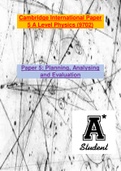Resumen
Summary (CAIE) Cambridge A Level Physics Paper 5 Revision Notes (9702) NEW
- Grado
- A level physics
- Institución
- A Level Physics
These are the full revision notes which cover all the necessary knowledge required by the syllabus for the CAIE A Level Physics Paper 5 Exam (Planning, Analysis and Evaluation). It also covers typical past paper questions and it explains them with diagrams and extra info. The syllabus code is 9702....
[Mostrar más]



